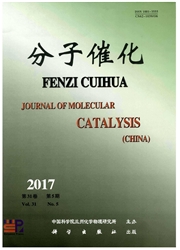

 中文摘要:
中文摘要:
运用化学共沉淀法,制备了尖晶石型(Zn1-xCdx)2SnO4(x=0.04,0.05,0.06,0.07,0.08)纳米粉体.通过X射线衍射分析(XRD)、光电子能谱分析(XPS)、扫描电镜(SEM)、比表面积分析(BET)及光度法等手段研究了粉体结构及不同掺杂量对光催化活性的影响,确定了最佳掺杂量和热处理温度.以波长λ=312nm的光源对甲基橙水溶液进行光催化降解实验,讨论了光催化剂用量、甲基橙浓度、催化剂烧结时间、试液的pH值、光照时间等与甲基橙脱色率的关系.结果表明,该复合氧化物粉体平均粒径小于30nm,属立方晶系.在实验条件下,Cd^2+的加入使Zn2SnO4的光催化活性明显提高,甲基橙的脱色率可达到98%.
 英文摘要:
英文摘要:
A series of spinel type ( Zn1-xCdx)2SnO4 (x = 0.04, 0.05, 0.06, 0.07, 0.08 ) nano powders were pre- pared by the coprecipitation method. The microstructure of the new powders, the effect of different Cd doping content on the photocatalytic activities, the optimal Cd doping content and the heat-treating temperature were investigated by XRD,XPS, SEM, BET and spectrophotometer. The degradation experiment of methyl orange aqueous solution was performed by the photo-catalytic methods on the light of wavelength (λ=312nm ). In addtion, the relation in the amount of catalyst, initial concentration of methyl orange, calcining time of catalyst, pH of methyl orange solution and illumination time with the decolorizing efficiency of methyl orange were discussed. The results indicated that the average particle size of the powder of the cubic (Zn1-xCdx)2SnO4 was less than 30 nm and the catalytic activity of Zn2SnO4 is clearly improved owing to Cd doping. Under experimental condition, methyl orange aqueous solution degradation rate reaches to 98%.
 同期刊论文项目
同期刊论文项目
 同项目期刊论文
同项目期刊论文
 期刊信息
期刊信息
